While the 27th November, 1861 represents the inception of local government in the Parramatta area, the City of Parramatta Council Archives hold records relating to local administration in Parramatta that date even further back - to 1846.
Here, we’ll dive in deeper to look at the development of local administration in Parramatta prior to 1861, and the records we have in our Archives, along with some photographs from our Local Studies Library, that reflect this period.
The Traditional Owners of the area now known as Parramatta are the Darug Peoples.
European settlement in the area commenced in 1788, when Governor Phillip established an outpost at what was then called Rose Hill. The name of the area was changed to Parramatta in 1791.
In colonial NSW, the administrative management of Parramatta was first the responsibility of the Governor and the military.
In 1812, Governor Macquarie set aside an area for a market in Parramatta near St. John’s Church. The Market Place was situated at the site that is now Parramatta Town Hall.
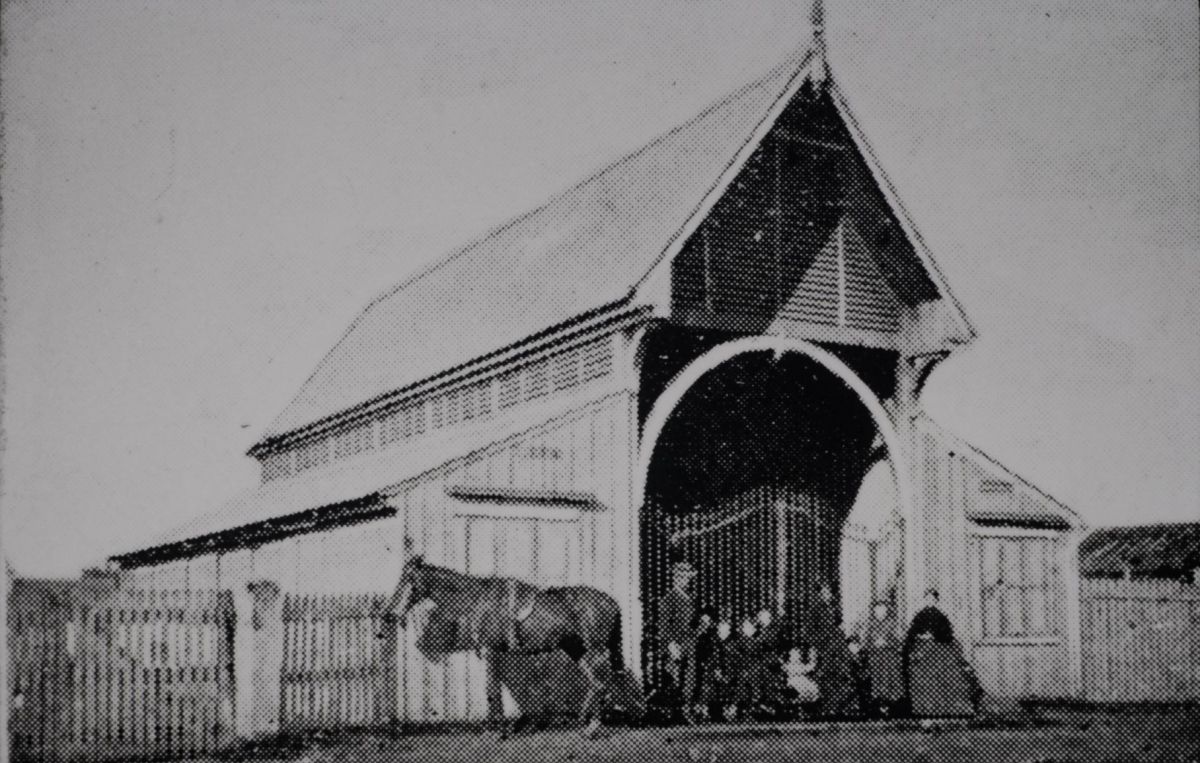
Originally, the control of the markets was assigned to the Governor and any revenue was paid into, and expenses met, from the police fund. Early legislation was concerned with fixing charges at markets, followed by the Markets Commission Act of 1839 coming into effect.
By 1841, the Parramatta Market was to play a local administrative role as it was the first to operate under a commission, with the first election held on the 23rd February, 1841. The 5 commissioners elected were James Byrnes, Henry Harvey, James Pye, Nathaniel Payten and Edward New. They were appointed to manage the general administration of the markets, including the erection of buildings and facilities, the appointment of officials and to organise the collection of dues.
The Parramatta Market was administered by commissioners until 1862, when no notice was posted for the triennial election and the system became defunct. In 1866, legislation was enacted to transfer the responsibility of the markets to the Parramatta Municipal Council. The Market Trust’s 1846 minute book was transferred into the Council’s hands and is now one of the earliest records we have in our Council Archives.
The images below are an excerpt from the first entry in the minute book dated 13th July, 1846:
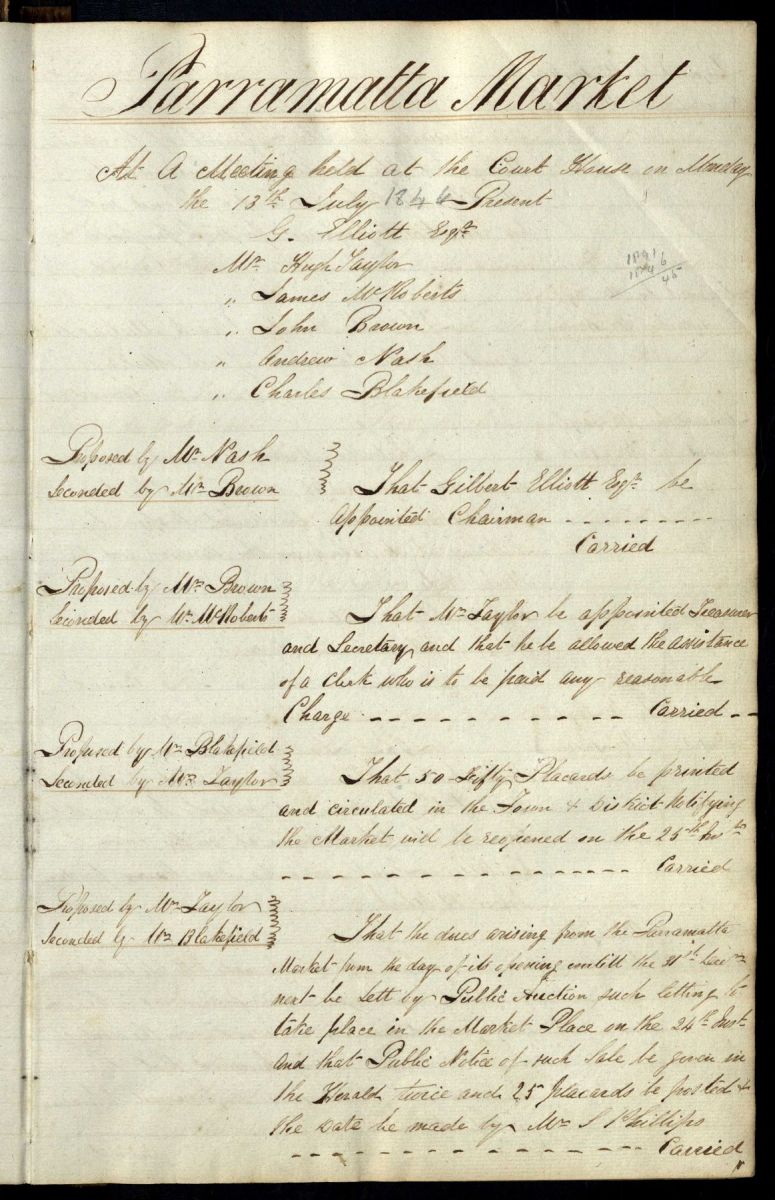
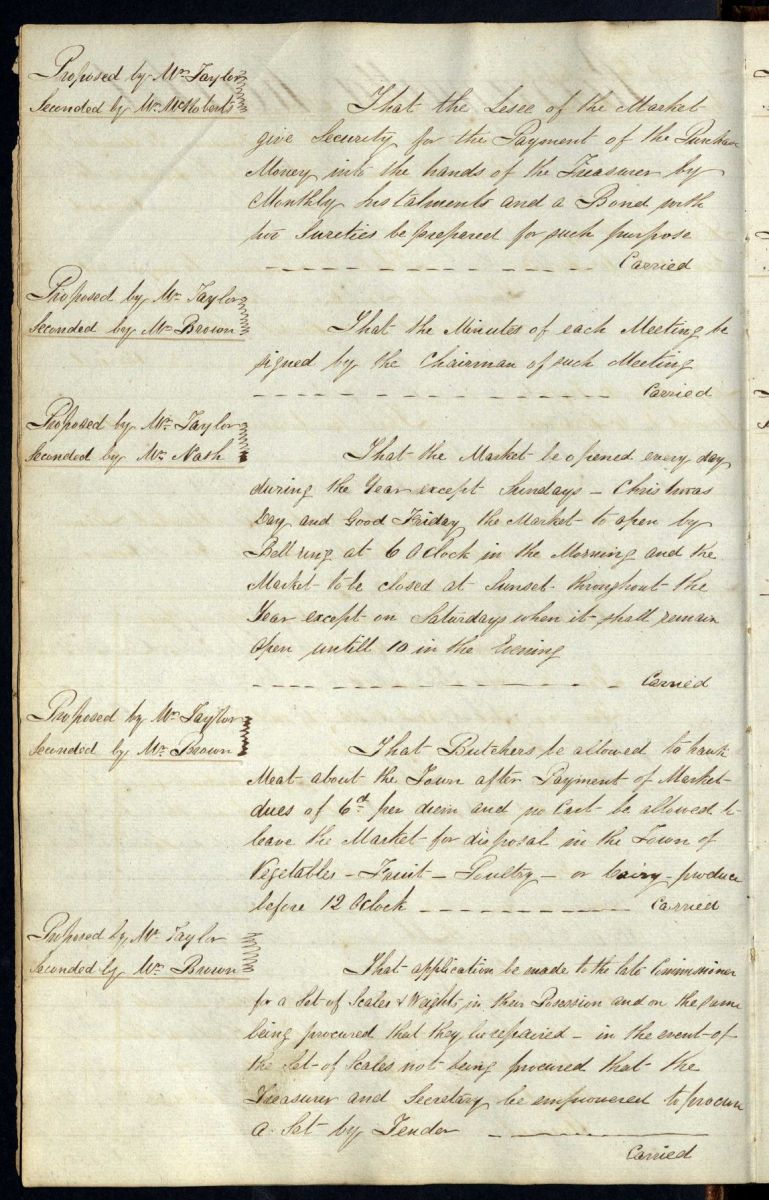
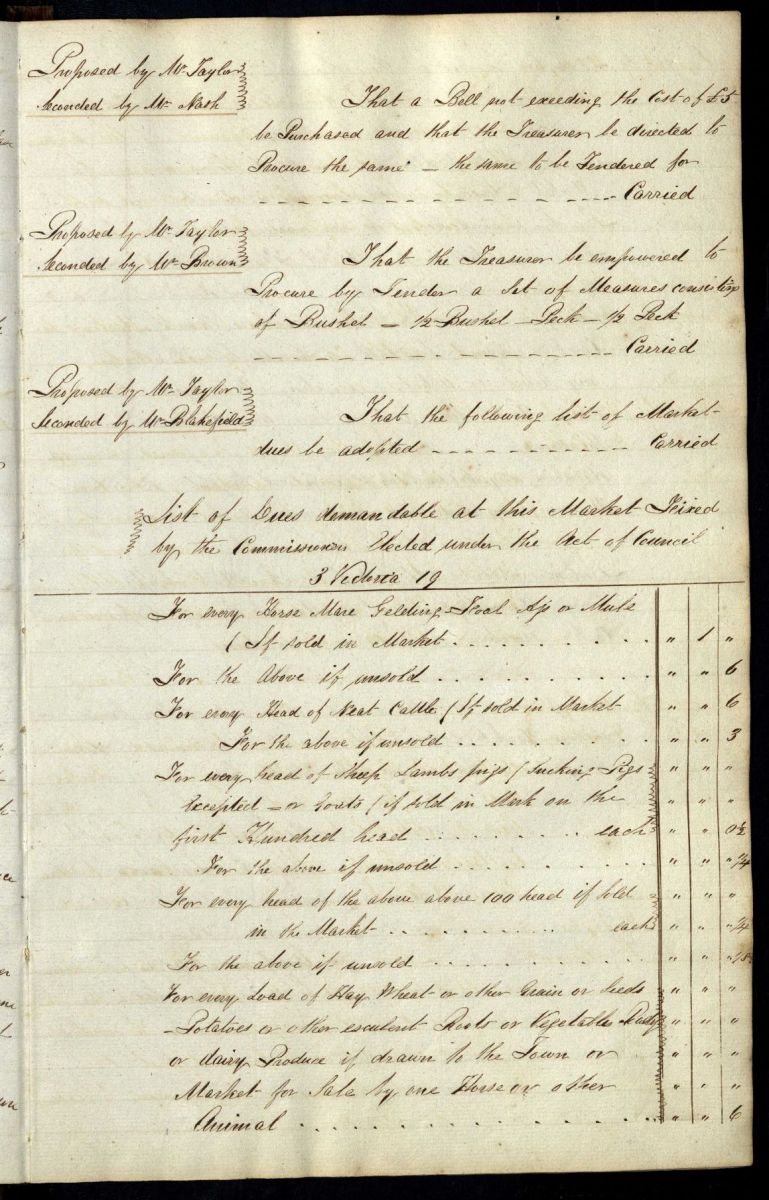
The minutes reveal some interesting insights into life in Parramatta in the 1840’s, including the opening and closing time of the markets, dues payable for items sold, and even the cost of the bell that was rung at 6am every morning to signal that the markets were open.
The Parramatta Markets ceased to operate in 1878, and the following year legislation was passed to permit the council to build a Town Hall on the site.
The Markets Commission was not the only form of early local administration in Parramatta. In April 1811, two toll bars were opened on the road from Sydney to Parramatta: one in George Street, Haymarket and the other in Church Street, Parramatta. In 1833, the Roads and Streets Act was introduced which aimed to classify the roads of the County of Cumberland according to the source of responsibility for their construction and maintenance.

In 1838, the Police Act was extended to Parramatta. The Governor was to appoint two or more Justices of the Peace to execute the duties of the Police Magistrate for “the removal and prevention of nuisances and obstructions in the said towns and for the better alignment of streets therein respectively.”
The Police Act omitted rating powers but provided for fines for the breaches of regulations. This included a number of local matters, such as governing damage to public property, watercourses and public fountains, rubbish on footpaths, building lines and the cleansing of butcher shops and slaughter houses. Fines could also be issued for the beating of carpets, the flying of kites and any billiard houses open, or public gambling that occurred, on a Sunday. Town surveyors could be appointed to set out footpaths, affix names to streets and approve of paving. The task of managing the town was to be undertaken in conjunction with police duties. By 1840, there were thirty police districts in NSW.
In 1842, An Act for the Government of New South Wales and Van Diemen’s Land was put into place that established limited elected representation in the colonial NSW parliament along with the introduction of district councils. The Parramatta District Council was proclaimed on the 24th August, 1843, covering the area of the Parramatta police district.
Under the Act, the Governor had the power to set the boundaries of each district council and was to appoint the first council in each district, thereafter to be elected by “qualified inhabitants.” The council was to have a warden (chairman) and a number of councillors determined by the population of the district.
The eligibility to be a councillor was limited to “natural born or naturalised” candidates holding a freehold estate in lands and tenements in NSW of yearly value of £100 or worth £2000. Eligible voters were owners of property worth £200 or householders occupying a dwelling of £20 annual value.
The 1841 census gave the population of Parramatta as 10,052 with 1,393 permanent houses. The warden of the 1843 council was Gilbert Elliot, a police magistrate, and there were nine councillors: Mathew Anderson, James Bettington, Patrick Hill, Thomas Forster, Andrew Murray, Nelson Lawson, James Byrnes, William Rutledge and George Suttor.
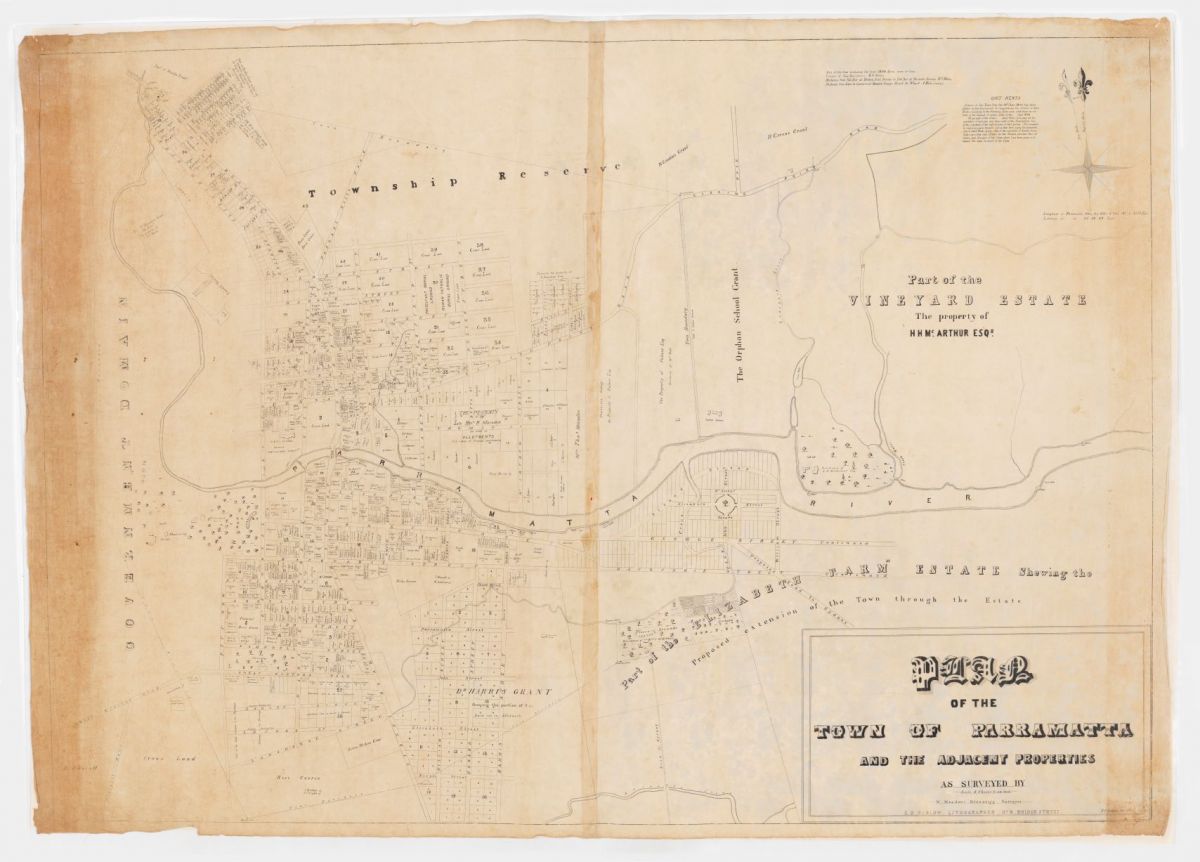
District councils had the powers to make by-laws that authorised the construction and maintenance of roads, bridges and public buildings, and to establish schools financed through rates and tolls. Under the Act, the councils were responsible for funding half the cost of gaols and police administration in their districts.
The district councils established in 1843 faced many challenges due to a lack of income and limited powers. The 1838 Police Act gave the police magistrate jurisdiction over streets, footpaths, buildings, night soil removal and public health matters.
However, the Parramatta District Council had some success in deriving an income from monies levied at the toll gates at Broken Back Bridge, Beckett's Bridge and Pitt Row, as well as the ferry tolls at Bedlam Point. The council was able to spend the money on road repairs and public works: it was responsible for the Parramatta to Sydney road, Dog Trap Road (now Woodville Road), the Parramatta to Windsor Road and the road to Emu Ford. The income from tolls was used to pay the salaries of a surveyor, overseers for convict work gangs, a treasurer and materials for road and bridge repairs.
As early as December 1844, newspapers started to report on meetings held in Parramatta to discuss the incorporation of the town. To explore more of the records held in our Archives and the proclamation of Parramatta as a municipality, you can read further here: The Proclamation of Parramatta as a Municipality.
![]()
Paige Davis, Archivist, City of Parramatta, 2021
Select Bibliography
Jervis, J. 1961. “The Cradle City of Australia: A History of Parramatta 1788 – 1961.” The Council of the City of Parramatta, Sydney.
Larcombe, F.A. 1973. “The Origin of Local Government in New South Wales 1831-58.” The Griffin Press, Adelaide.
Laverty, R. 2010. “The Evolution of Municipal Government in Brisbane 1838-1859” in The Queensland History Journal Vol. 20, No. 13, pp. 847 – 857.
“Local Government Research Guide.” NSW State Archives, Last Accessed 13/10/2021: https://www.records.nsw.gov.au/archives/collections-and-research/guides-and-indexes/local-government-research-guide.
New South Wales Auditor-General’s Department. 1845. “Abstract of the Revenue of the Colony of New South Wales and of its Appropriation – 1844.” William John Row Government Printer, Sydney.
1845 'NEWS FROM THE INTERIOR.', The Sydney Morning Herald (NSW : 1842 - 1954), 11 July, p. 3.


